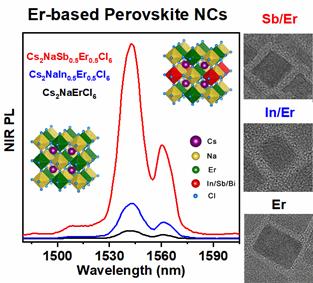Recently, a research team led by Prof. Han Keli from the Institute of Molecular Sciences and Engineering, Institute of Frontier and Interdisciplinary Science, Shandong University, Qingdao, in collaboration with Prof. Miao Xiangyang's group from Shanxi Normal University,revealed the colloidal synthesis and exciton dynamics of all-Inorganic RE-based DP NCs with NIR emission.
This study titled "All-Inorganic Rare-Earth-Based Double Perovskite Nanocrystals with Near-Infrared Emission" was published in Laser & Photonics Reviews (https://doi.org/10.1002/lpor.202100218).

NIR PL emission spectra and HRTEM images of Cs2NaEr0.5B0.5Cl6NCs(Image by Han Peigeng, Wu Ruixiang)
Lead-free halide perovskite nanocrystals (NCs) have been widely studied. Researchers have mainly focused on the photoluminescence (PL) in the visible region. However, the investigation on the near-infrared (NIR) PL of lead-free perovskite NCs is rare, and NIR PL quantum yield (QY) is usually low, especially for telecommunication wavelength of ~1.5 μm. Therefore, it is of great significance to further enhance NIR PLQY and have a deeper understanding of the photophysical process. So far, there has not been any report on NIR emittingrare earth (RE)-based DP NCs.
The scientists synthesized all-inorganic RE-based Cs2NaEr1-xBxCl6(B: In, Sb, Bi; x = 0, 0.13, 0.5)DP NCs by the variable temperature hot injection. The difference with many visible light-emitting perovskite NCs is that all these NCs exhibit a NIR PL emission from 4I13/2→4I15/2 transition of Er3+. On account of the incorporated Sb3+, Cs2NaEr0.5Sb0.5Cl6NCs show a 23-fold NIR PL enhancement with the average lifetime of 119.1 μs.They found thatthe origin of NIR PL enhancement was attributed to the increase of exciton absorption, the longer PL lifetime, the suitable phonon-assisted process caused by the indirect band structure, and the process of long-lived dark trap state assisted NIR PL emission. This work opens up an effective way to design novel Er-based DP NCs with high-performance NIR PL, which has potential applications in NIR LEDs, optical communication and quantum storages.
This work was supported by the National Key Research and Development Program of China, the National Natural Science Foundation of China, and the Scientific Instrument Developing Project of Chinese Academy of Sciences (CAS).